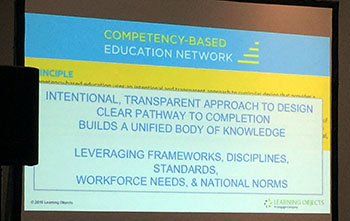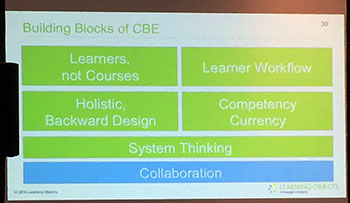Why Introverts Are Critical For Your Team; Moving Toward E-Assessments; and Building Blocks For Competency-Based Education – Lessons From Educause 2016

Introverts are critically important to growing organizations. They can provide creativity and innovation, and prevent group think. Research over the past 40 years has shown that introverts make excellent leaders, much more so than stereotypically charismatic alpha males. Think Mark Zuckerberg, Bill Gates, and Abraham Lincoln. Healthy organizations strive for a mix of styles, which is why Zuckerberg and Gates chose extroverted COOs for their teams. The book, Good to Great described 11 top companies, each of which turned out to be led by a quiet, modest, even shy, CEO.
Susan Cain’s opening keynote, Quiet: How to Harness the Strengths of Introverts to Change How We Work, Lead, and Innovate, described about how to maximize the benefits that introverts bring to teams. Her poll of the audience found that the IT crowd was split 70-30 in favor of introverts. Which explained why most of the audience was in near-panic when she asked that they form groups of four and share their most personal stories describing what made them who they are today. You can imagine the sigh of relief when she confessed she was only kidding.
Introverts make up 1/3 to ½ of the population. When you work with them, be sure to give advance notice of what you will be looking for. Share ideas online. Extroverts should curb their enthusiasm somewhat around introverts. For their part, introverts should try to step outside their comfort zones to let their ideas be known. Speaking up early in meetings can help. When Google studied what set apart their most successful teams, they found that providing psychological safety made the biggest difference.
Susan Cain is the co-founder of Quiet Revolution and author of Quiet Power: The Secret Strengths of Introverts and Quiet: The Power of Introverts in A World That Can’t Stop Talking. Her TED talk is one of Bill Gates’ all-time favorite.
How to Move Toward E-Assessments
The concept of computer-based testing is growing in higher education. E-assessments may be online or offline, and usually take place under closely tightly-supervised conditions. Last year Rob Peregoodoff of the University of British Columbia’s Sauder School of Business described how they implemented large-scale BYOD mid-terms and finals. This year Jeffery Tay of National University of Singapore delivered a poster (see below) about How to Move toward E-Assessments, Teaching and Learning’s Final Frontier.

A simple approach to technology-based testing is to completely lock down the computer so that it can run only the test program with no access to the Internet. A better approach is to use network management software to carefully control the resources that the computers can access. It’s often desirable to permit collaboration and chat spaces on the computer screens to provide help with clarifying questions and other permitted topics.
Building Blocks For Competency-Based Education
The promise of competency-based education (CBE) is looming ever-larger over pedagogy and is an important topic for Educause. The concept aims to express student knowledge in competency currency, rather than in blunt credit hours. It enables student advancement based on content mastery, rather than simply time spent on a subject. It opens the door to personalized learning. To date, though, the promise of CBE has yet to be realized.

A definition of competency-based education as proposed by Jonathan Mott.
To address this issue, Jonathan Mott, Chief Learning Officer of Learning Objects, and Eric Denna, CIO of University of Maryland, propose Building Blocks of CBE: Backward Design, Authentic Assessment, Credentials, and Evidence-Based Learning (see graphic below). Included in the building blocks is a competency currency, to replace the simple metric of credit hours, which even when combined with traditional class grades does not accurately reflect what a student actually learned in any given subject. The currency could encompass micro-credentials such as badges and would lead to a competency transcript to replace the existing credit hour transcript.

Building blocks for successful CBE
Understanding and implementing these building blocks will help unlock the potential of CBE. Challenges lie in adapting legacy constructs like the 14-15 week semester, existing financial aid expectations, and tradition LMS software, which is organized around classes and does not recognize the concept of competencies. Unfortunately, the next major step toward CBE is being held back while each of the two proponents, i.e. the institutions and the vendors, wait for each other to invest in the next major step.
This blog was originally authored by Robert Nilsson, Director of Vertical Solutions Marketing.